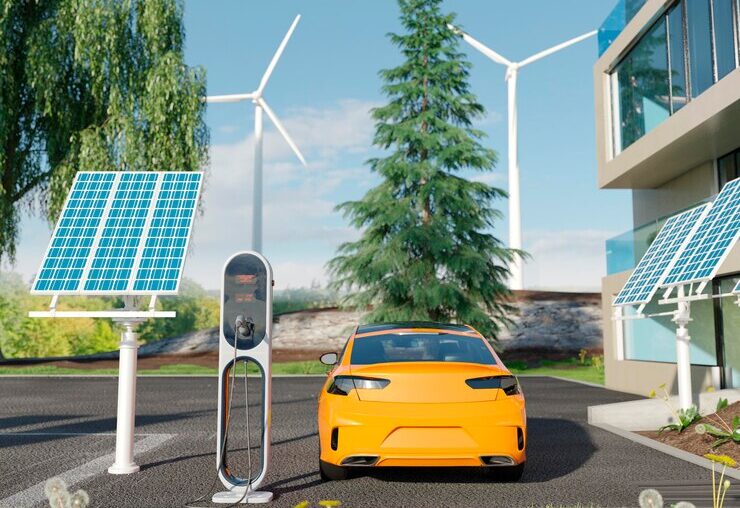Indeed, as the world drifts toward sustainability, electric vehicles have become in greater demand. Consequently, the need for efficient and reliable EV chargers has never been higher. Just like any electrical equipment, proper maintenance will ensure that an EV charger works well, efficiently, and for a long time. Failure to keep your car’s electric vehicle charger properly serviced may lead to problems such as slow charging times, overheating, or worse, causing a safety hazard. In this article, we shall discuss how important EV charger maintenance is and how to practically sidestep common problems with the charger. It will help you ensure that your charger remains reliable and that your vehicle stays charged, every time you’ll need it.
A) Why Routine EV Charger Maintenance Is Essential:
An EV charger requires proper care; maintenance is not merely keeping the charger running but optimizing performance and safety of that investment. Here are a few reasons why routine maintenance is essential:
1) Prevent Electrical Failures:
Electrical charging for EV chargers takes place in voltages with a quite considerable magnitude, which charges the car’s battery. If not monitored properly, in some cases, a low connection or poor wiring might lead to electrical failure or the worse-case scenario-short circuits. These issues sometimes occur before becoming complex and costly if regular checks are performed.
2) Extend the Life of Your EV Charger:
Routine maintenance keeps your EV charger for a longer period of time. Remember how if you take good care of your car, it will last you longer? Similarly, in the case of any machine, routine care reduces wear and tear. Small issues are resolved without turning into major problems, hence saving money on heavy repairs or replacement.
3) Ensure Optimal Charging Speed:
A slow charging battery will likely require servicing over time since electric car owners often rely on fast charging to get back on the road. Regular checks and cleaning of charger ports, cables, and connections ensure that your charger functions efficiently at optimal charging speeds.
4) Avoid Safety Hazards:
Faulty chargers may pose a risk of heat generation in the EV, electrical fires, and shocks. Maintenance of an EV charging station guarantees you the safety of usage of your charger with protection from hazards to your home, workplace, or public charging stations.
5) Save Money on Costly Repairs:
Preventive maintenance would prevent even more serious and costly repairs. By inspecting and maintaining your electric vehicle charger regularly, you would spot a small problem early on and could avoid catastrophic faults leading to a whole charger replacement.
B) Common EV Charger Issues and How to Avoid Them:
Knowing common issues that arise with the electric vehicle chargers can get you ahead of them through proper preventive measures. Here are the top issues that EV owners face and the steps you can take to avoid them:
1) Slow Charging or Inconsistent Charging Speed:
One of the most usual complaints about EV chargers is that their charging speeds gradually slow down over time. When you notice your car taking longer to charge than previously, it is high time to check on the following:
i) Dirty or Worn Charging Port:
Dust, dirt, and debris tend to settle over time in charging ports thereby causing a poor contact between the charger and the vehicle. Clean charging ports with a dry, lint-free cloth periodically.
ii) Worn-Out Cables:
Inspect the charging cable for any signs of wear, fraying, or damage. A damaged cable can reduce the power transmission to the vehicle and slowing down the charging speed. If you find any damage, replace the cable right away.
iii) Loose Connections:
The contacts on a charging plug will eventually get loose, and this results in erratic charging. Before starting the charging process, always inspect whether the connection between the charger and the vehicle is loose or not.
2) Charger Overheating:
The other common issue is overheating, which probably leads to decreased performance and possibly safety risks. The causes for such include:
i) Lack of Ventilation:
Good airflow is a prerequisite for chargers not to overheat. Ensure that you install your charger in an area that has adequate ventilation with no obstruction.
ii) Overuse and No Cooling Breaks:
Overworking your charger without cooling for a long period will cause it to overheat. If you have installed the charger for more than one vehicle or if you use it for extended periods of charging, you should cool it before you use it.
iii) Faulty Internal Parts:
Overheating can be a sign that some component within the charger has improper internal elements. When your charger overheats even after ensuring adequate ventilation, you should seek the help of a technician and have him inspect the device for internal faults.
3) Charger Not Powering On:
A non-functioning charger may also be quite inconvenient to use, and you can expect the following probable causes:
i) Blown Fuses or Tripped Circuit Breaker:
The power surge or electrical faults may have blown the fuses or tripped your circuit breaker, thus breaking the charger. Check your electrical panel for everything to be fine.
ii) Faulty Power Supply:
Problem with the power supply unit or plug can prevent electricity from being distributed to the charger. Examine the power cord and outlet for visible damage.
iii) Malfunctioning Software or Firmware:
Some EV chargers have intelligent capabilities and therefore require periodic software updating. Consult the manufacturer’s instructions for any update that may need to be installed in order to resolve the power issues.
4) Cable or Port Damage:
This charger’s cables and ports are so prone to damage with constant use. To prevent costly repairs, carry out the following routine maintenance tasks:
i) Regular inspection of cables:
Check your charging cable for any visible wear and tear signs such as cracks, fraying, or cuts. Damaged cables should be replaced immediately, and further damage should be prevented.
ii) Port Cleaning:
Dust, debris, and dirt settle inside the charging port and lead to bad connection. Clean the port regularly by using a soft cloth in order to remove amassing.
iii) Proper Handling:
Make sure to handle the charging cable properly. Do not twist or pull to avoid damaging it. Store it safely when not in use so you do not develop kinks or damage.
5) Breakdown in Communication Between Vehicle and Charger:
In other cases, there could be a problem of communication between the charger and the vehicle, thus a charger failure. This is normally caused by:
i) Outdated Software:
EVs and smart chargers often require software or firmware update. Get updates regularly on your vehicle and the charger so communication will be complete.
ii) Lousy Charging Parts:
Now, inspect the charging part, cable, and its connections for any damage which could interfere with the communication between the charger and the car.
C) Routine EV Charger Maintenance Checklist:
This is how to maintain your EV charger to its highest level with this routine maintenance checklist:
1) Monthly Visual Inspection:
i) Check for Wear and Tear:
Check Your EV Charging Cable, Plug, Port for Signs of Wear and Tear. Inspect the charging cable, plug, and port for visual signs of wear and tear, like cracks, fraying, or loose connections.
ii) Charge Port Cleaning:
Take the removal of dust and debris on the charge port using a dry cloth.
iii) Ensure Proper Ventilation:
Mount the charger in a well-ventilated area free from obstructions.
2) Quarterly Electrical Inspection:
i) Test Power Output:
Using a multimeter, test the power output of the charger if it conforms to the manufacturer’s standard.
ii) Check Circuit Breakers:
ensure that the circuit breakers and fuses to which your EV charger is connected are in good working order.
iii) Monitor Charging Speeds:
Track the time it takes to fill up your vehicle, without showing significant variation in its charging speed.
3) Biannual Professional Check-Up:
i) Hire an Authorized Electrician:
Let a licensed electrician examine your charger’s internal parts and the electrical system it connects to. He might be in the position to identify latent faults before they escalate into major catastrophes.
ii) Charger Firmware and Software Update:
Check if you have firmware or software upgrade from your charger manufacturer. Your update will get its compatibility right for newer EV models and possibly enhance performance.
4) Annual Deep Cleaning:
i) Clean the charger properly:
Each and every part of the charger must be cleaned with a soft, damp cloth with utmost care. Do not ever let the charging ports or the electrical parts to get wet.
ii) Inspect for Rust or Corrosion:
In case of installation of chargers outdoors, you must ensure that there are no signs of rust or corrosion and, if present then start treating them immediately.
The Final Words:
The way to avoid such problems as slow charging speed, overheating, or hazards, is to perform routine maintenance of your EV charger. Maintaining your EV chargers by sticking to a schedule will ensure that all chargers function well, are safe to use, and last for years to come. Whether you are an individual owning an electric vehicle or are managing multiple chargers in a business or at work, proper upkeep will save you from high repair costs and give the users trouble-free experience.
If you implement these servicing practices into your lifestyle, you will be certain to avoid problems from developing, and you’ll be sure to reap the maximum benefits of your long-term, dependable, effective use of an EV charger.




